One of America’s greatest bridges, carrying the heaviest traffic in Northern California.
The San Francisco–Oakland Bay Bridge (henceforth, Bay Bridge), completed November 12, 1936, during the Great Depression, remains one of the world’s greatest bridges. Together with its neighbor, the Golden Gate Bridge, it represents the culmination of more than 100 years of bridge engineering development in the US. After its opening, the bridge, which connects San Francisco and Oakland, soon became known as the “workhorse of Northern California,” carrying the heaviest traffic in the region. As part of Interstate 80, it remains the busiest traffic link in Northern California carrying on its two decks up to 280,000–300,000 vehicles per day, or more than 13,000 per peak hour.
The bridge consists of several structures with distinctly different systems, connected to form an 8.5 mile cross-bay roadway, nearly 4.4 miles of it over water. The main portions of the original bridge were:
- West Crossing Span: Twin suspension spans with two decks. Central spans of over 2,310 feet. Total length of nearly 2 miles from San Francisco to Yerba Buena Island (YBI), see Figure 1.
- YBI Segment: A two-level tunnel and short concrete viaduct, with a length of 1,800 feet.
- East Crossing Span: Consisting of several different steel truss systems: four short 288-foot spans on YBI, followed by the 2,420-foot long cantilever structure (Figure 3), then five deep through-truss spans of 509 feet each, fourteen deck-truss spans at 288 feet, and steel structures. More than 2 miles long crossing from YBI to Oakland.
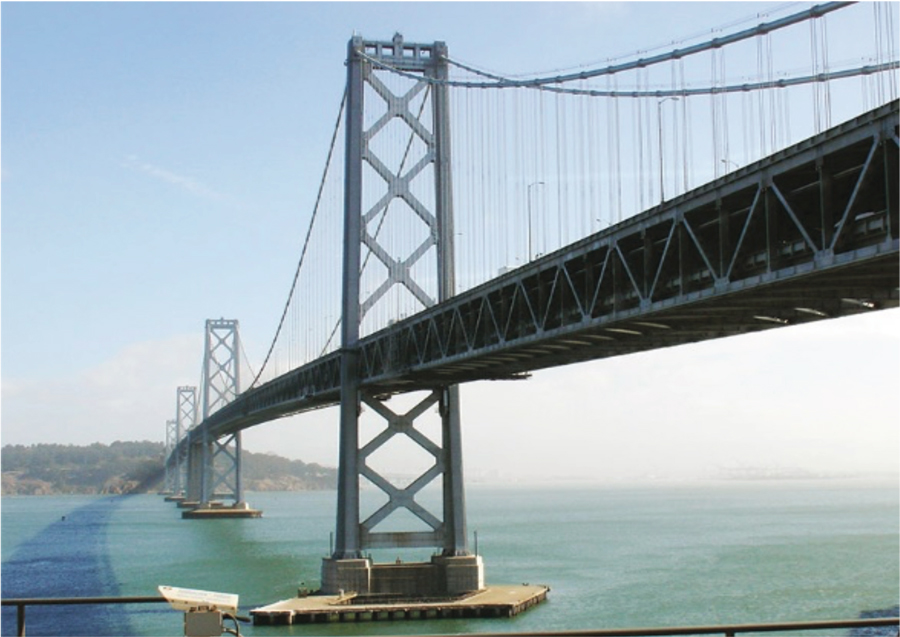
The original bridge was designed by Ralph Modjeski and Charles Purcell, among others, and was built by the American Bridge Company from 1933 to 1936, for a total cost of $77 million, with steel from United States Steel. Upon opening, it was the longest highway bridge in the world. It had the second longest suspension span (2,310 feet), the third longest cantilever truss span (1,400 feet), the deepest pier foundation below water (243 feet) and the largest bored tunnel. The West Crossing was also the only major bridge with two consecutive suspension spans.
The bridge is listed on the National Register of Historic Places (NRHP) with a note: “One of the largest and most important historic bridges in the country.” From the graceful West Crossing suspension structure, through the Yerba Buena Island tunnel and viaduct, to the steel cantilever truss section and truss spans, this entire bridge deserves to be remembered for these historic credentials. It was and it remains one of the greatest engineering achievements of the 20th century.
The engineers utilized state-of-the-art techniques available in the 1930s. They used the highest-strength construction steel available: nickel steel (55 ksi) and silicon steel (45 ksi) made up the larger portion of the total steel employed for the East Crossing. Even the carbon steel used in this bridge was higher strength (37 ksi) than that normally used today. The West Crossing suspension steel cables are 120 ksi. The structural steel used for the entire bridge amounted to 167,100 tons, or 125 psf.
Historical Development
Already before the beginning of the 20th century, the need for a bridge was felt by Californians in the San Francisco Bay Area. The self-proclaimed Emperor Norton I, an eccentric resident of San Francisco, thrice decreed that a suspension bridge be constructed to connect Oakland with San Francisco, the last time on September 17, 1872.
Unlike most of Emperor Norton’s eccentric ideas, his decree to build a bridge had wide public and political appeal. Yet, the task was a major engineering and economic challenge since the waters between San Francisco and Oakland were too wide and too deep to be tackled by the engineering technologies of the day. In 1921, over forty years after Norton’s death, a tunnel tube was considered, but it became clear that it would be inadequate for vehicular traffic. Support for a trans-bay crossing finally grew in the 1920s (An early idea for such a bridge is shown in Figure 2) with the increasing popularity and availability of the automobile. In April 1932, the preliminary plan and design of the bridge were approved, and preparation of the final design proceeded.
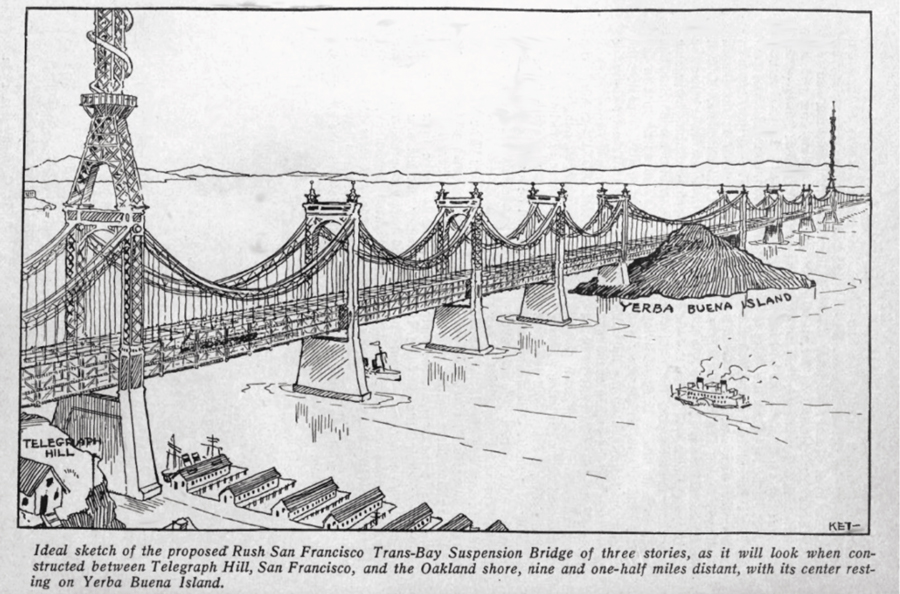
Original 1936 Bridge
Construction began on July 9, 1933, after a groundbreaking ceremony attended by former president Herbert Hoover, who declared: “This marks the physical beginning of the greatest bridge yet erected by the human race.” The bridge opened after just over three years of construction, justifying President Hoover’s appraisal by instantly becoming one of the greatest bridges ever built.
Since the Bay Bridge spans a long distance, it necessitated specific bridge structures for its different portions. Intersecting the maritime route into the ports of both San Francisco and Oakland, it required a minimum clearance of 220 feet above water. The western section of the bridge, between San Francisco and Yerba Buena Island, presented an enormous engineering challenge. Here, the Bay was up to 100 feet deep in places and would require new foundation-laying techniques. A single main suspension span 4,100 feet in length was considered but rejected. The solution was to construct a massive concrete anchorage halfway between San Francisco and Yerba Buena Island, and to build main suspension spans on each side of this central anchorage.
The West Span (original & current) is a continuous suspension structure with two suspension main spans of 2,310 feet, interconnected with a middle 2,490 foot span divided in two by the massive central anchorage. The total suspension part of the west span is 9,452 feet.
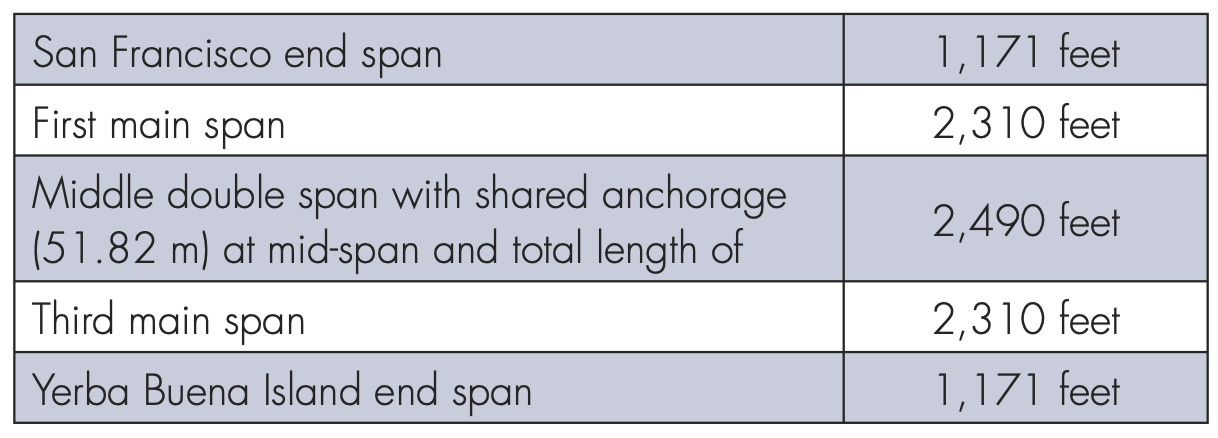
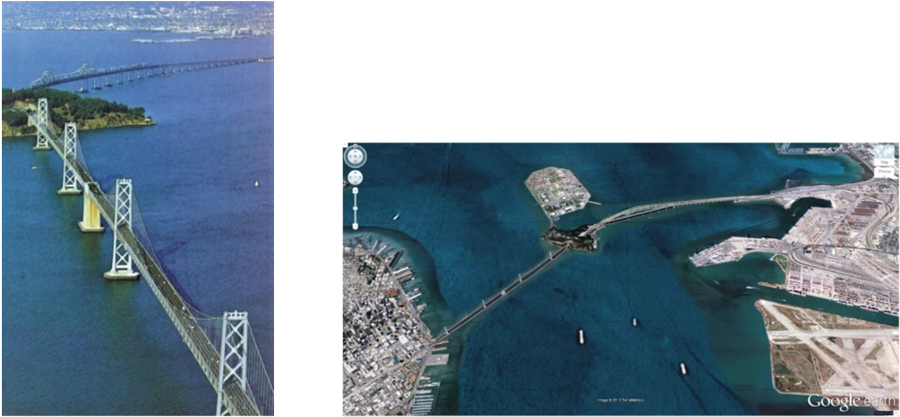
(Right) West and East Crossing Spans from above. Image courtesy of Google Earth.
The continuous suspension bridge spans (Figure 3), are as follows:
Reaching the Yerba Buena Island, the road goes through a two-story Yerba Buena Tunnel, which is 76 feet wide, 58 feet high, and 540 feet long. It is the largest diameter transportation bore tunnel in the world. The considerable amount of material excavated from boring the tunnel was used for part of the landfill north of Yerba Buena Island, creating the artificial Treasure Island.
The original East Span from Yerba Buena Island to Oakland with total length of 10,176 feet was a combination of a double cantilever truss structure (see Figure 4), five long-span through-trusses, and a multi-span steel truss causeway with spans of 492 feet. The cantilever truss span of 1,401 feet was the longest in the nation and the third-longest anywhere in the world.
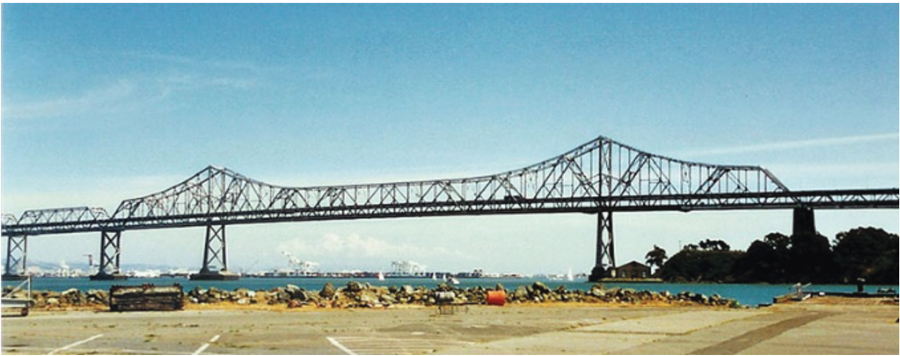
The foundations of most of the original eastern section were on treated wood pilings. Because of the very thick layer of mud on the Bay bottom, it was not practical to reach bedrock, although the lower levels of the “mud” are quite firm. Long wooden pilings were crafted from entire old-growth Douglas Fir trees, which were driven through the soft mud to the firmer bottom layers. However, these foundations were later the main reason for the decision to replace the entire East Span.
Bridge Changes from 1936 to 1989
The original bridge initially carried automobile traffic on its upper deck, with trucks, tramways, buses, and commuter trains on the lower deck, (see Figure 5). In 1958, the lower deck was converted to all-road traffic as well. In October 1963, the traffic was reconfigured to one way traffic on each deck, westbound on the upper deck, and eastbound on the lower deck, with trucks and buses now allowed on both decks.
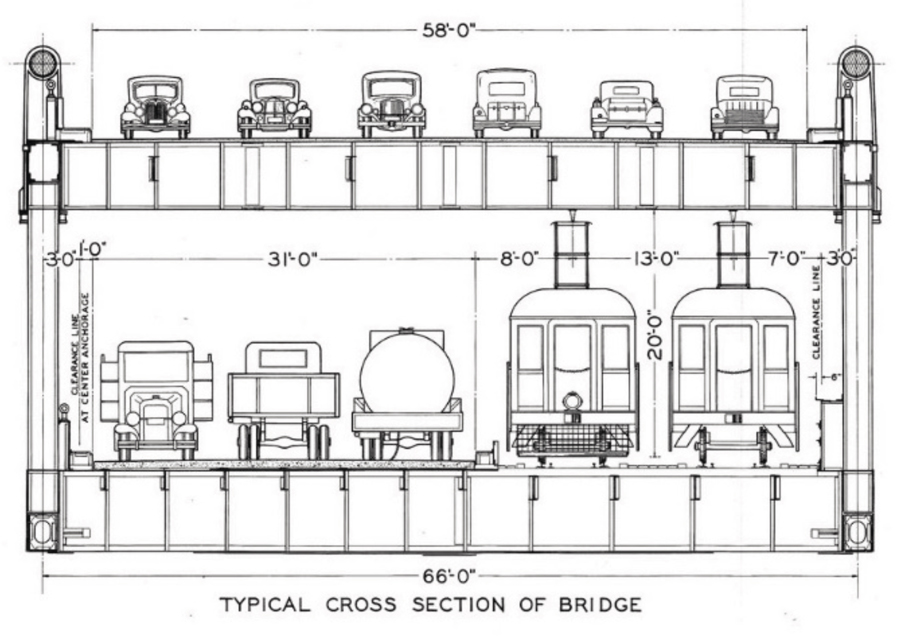
East Span Replacement 2002–2016 Following the Loma-Prieta Earthquake 1989
On October 17, 1989, a 6.9M earthquake hit Northern California. It had an epicenter on the San Andreas Fault, roughly 56 miles south of San Francisco, and lasted 20 seconds. As a result, a small 50-foot long upper deck portion of the East Span slipped from one of its supports and dropped onto the lower deck (Fig.6), necessitating month-long repair and initiating a heated discussion for the retrofitting or replacement of the bridge. The structural decision was to replace the entire East Span of the bridge completely, mostly because of the inadequate support capacity of its timber pile foundations and the very difficult retrofitting required for such foundations.
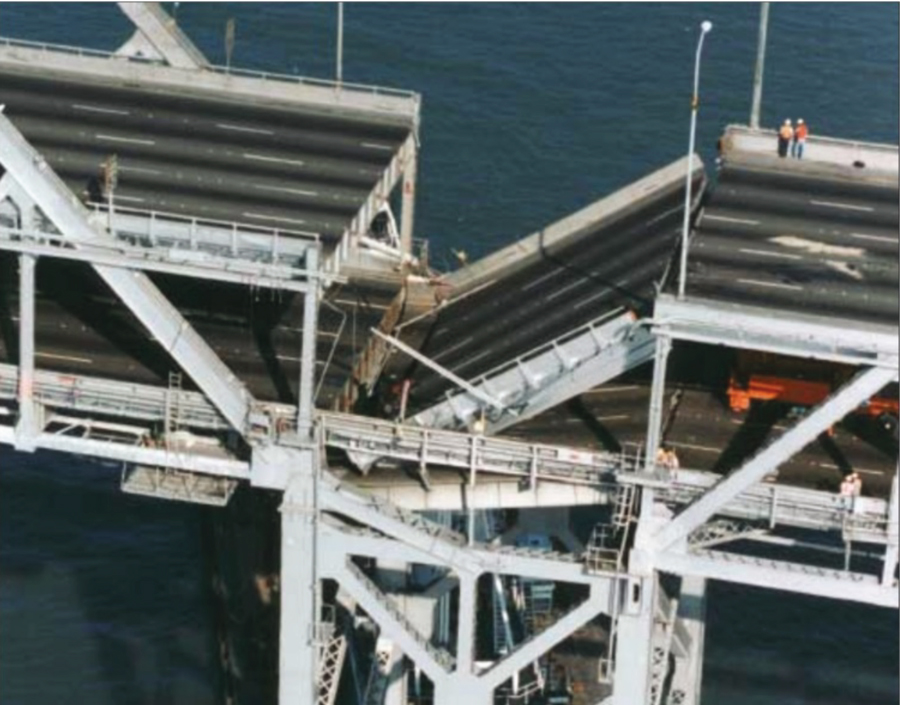
After several years of discussion, planning and design, construction on the new east crossing finally began in January 2002, and was completed after 14 years of construction in October 2016, for $6.5 billion for a length of nearly 2.2 miles, but without adding a single additional traffic lane to relieve the heavy congestion on the bridge. Partial traffic was allowed starting in 2013.
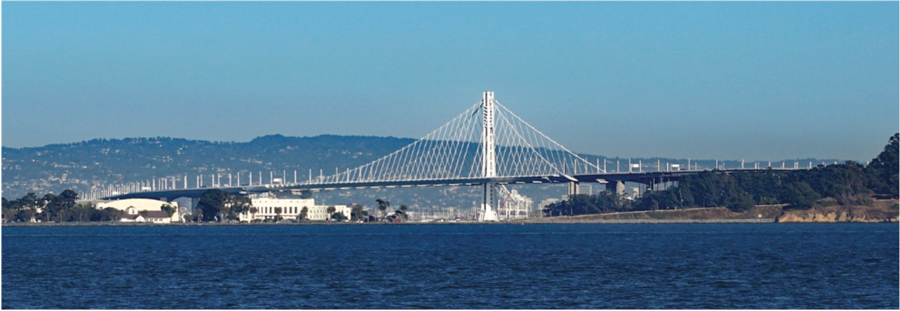
The East Span replacement was designed by T.Y. Lin International, Moffat & Nichol Engineers, Weidlinger Associates, and Donald MacDonald Architects. It is comprised of a single-tower, self-anchored suspension (SAS) steel span of 1266 feet, see Figures 7 and 8, and a 14-span (525 feet each) concrete skyway, see Figure 9. The new crossing has added shoulders and a bicycle lane, but there is no bicycle lane on the West Span.
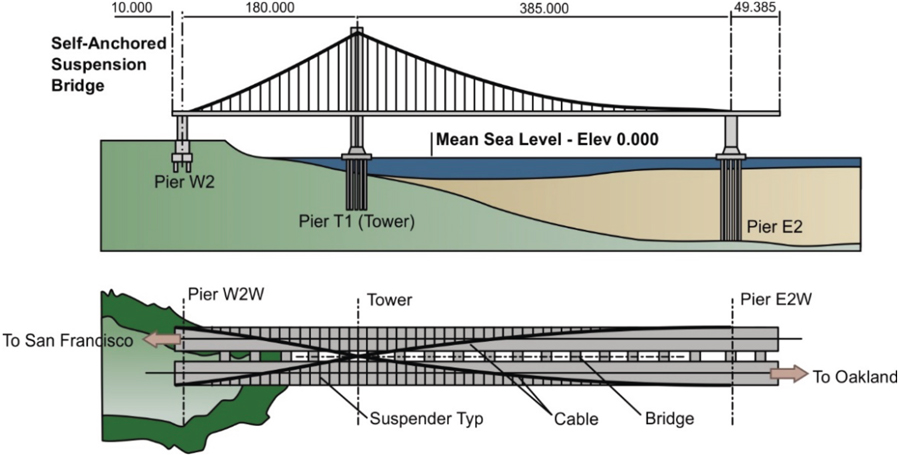
Unlike the double-deck western and the original eastern section of the bridge, the new replacement East Span (eastern part) consists of two single deck bridges carrying both eastbound and westbound lanes. Following completion of the replacement structure, demolition and removal of the old East Span began in 2016 and was completed on September 8, 2018, at an estimated cost of at least $250 million.
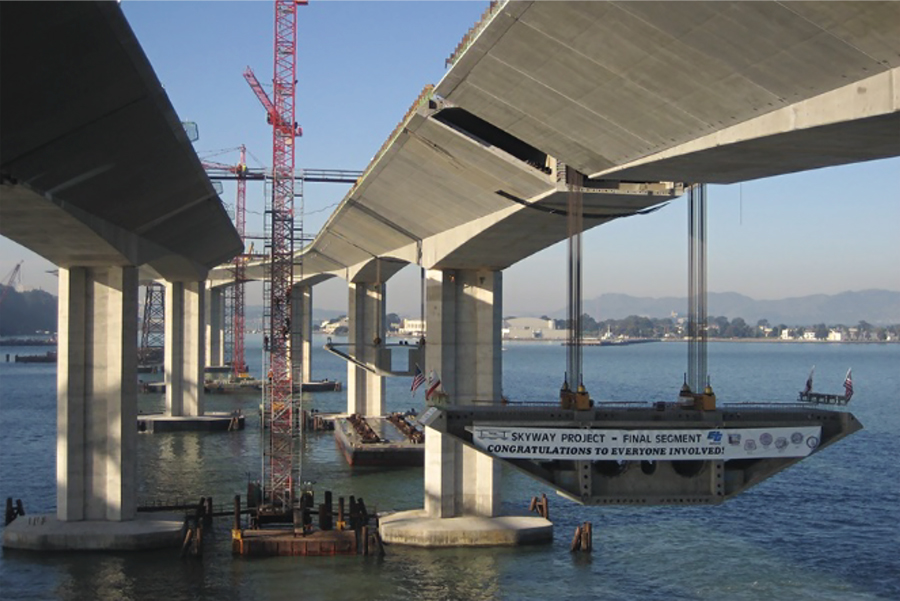
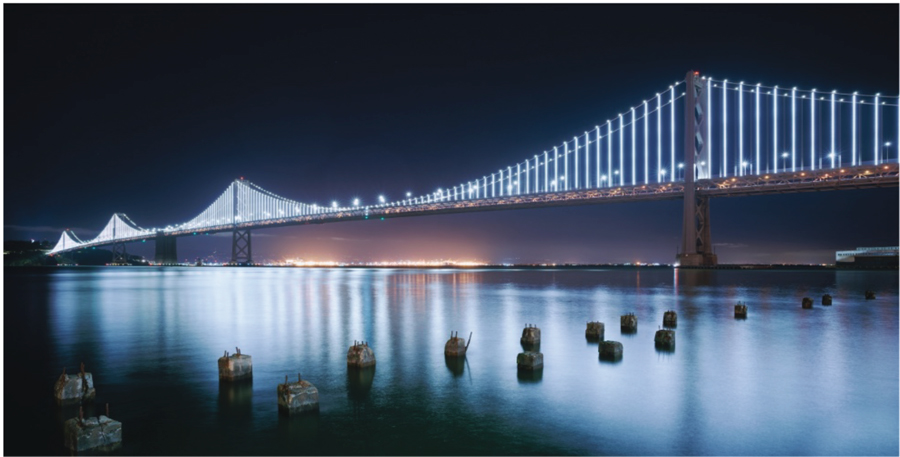
Replacement East Span/Technical data:
Cable-stayed “Signature” bridge with a main span of 1,263 ft a back span of 590 ft; and a total length of 2,048 ft.
Skyway, was constructed with multiple 525 ft spans of comprised of precast post-tensioned concrete segments. The total concrete utilized is 450,000 cubic yards. The total weight of the Skyway structure is 8.48 t/m2.
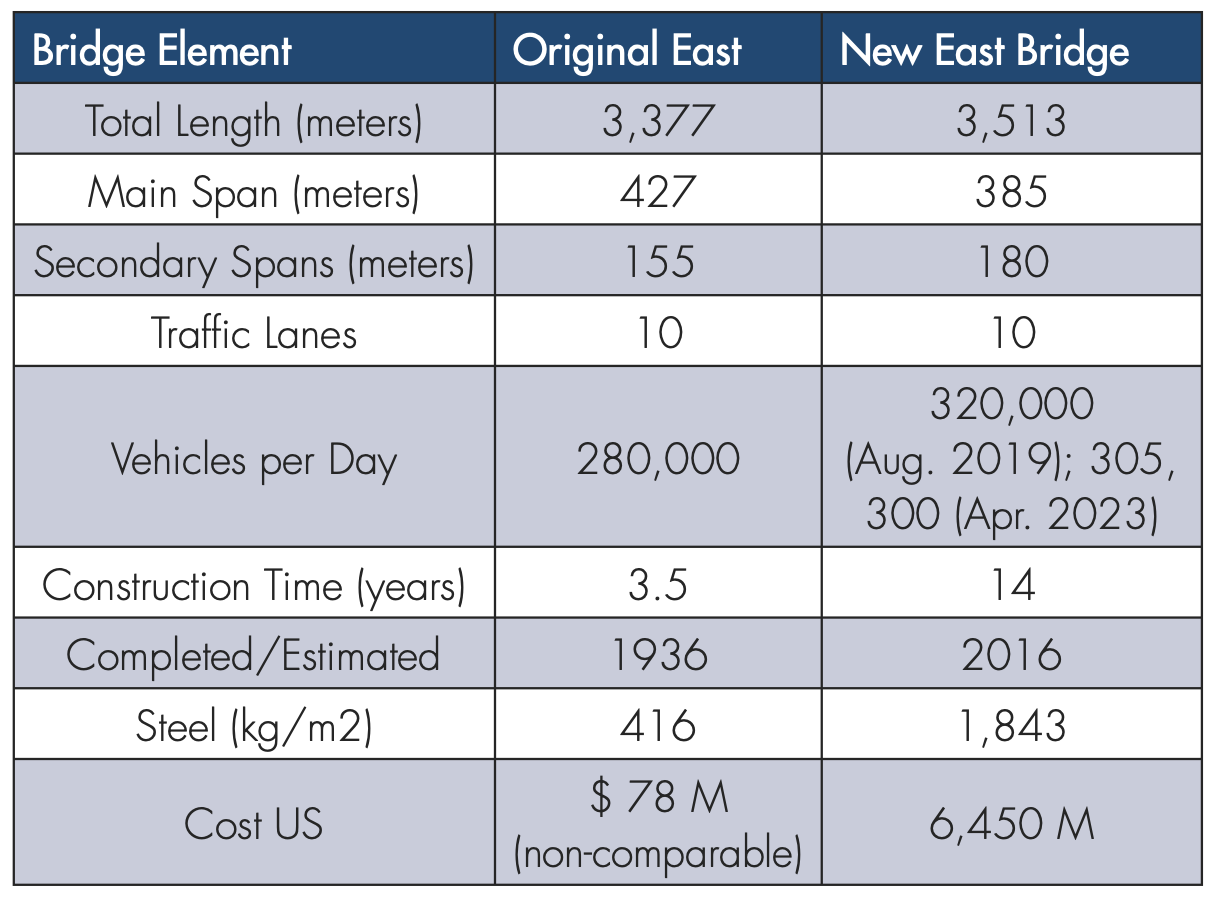
Seismic Safety Improvements to the West Span
The West Span (and its western approach) underwent seismic improvements in a five-year project beginning in 1999, at a reported cost of approximately $759 million. The improvements included massive rollers installed between the roadway and bridge supports and 96 new viscous dampers inserted at critical points to damp movement. The bridge’s twin suspension spans were strengthened by adding new steel plates and replacing half a million original rivets with almost twice than many modern high-strength bolts. New diaphragm bracing was added under both decks, and all the “laced” truss diagonals connecting the upper and lower road decks were replaced. In total, the project added about 8,500 tons.
Traffic
The San Francisco-Oakland Bay Bridge is the region’s “workhorse bridge,” carrying more than a third of the traffic of all the state-owned bridges combined. By 1990, Bay Bridge traffic had already reached 280,000 vehicles per day, which later increased to 320,000, creating one of the worst traffic congestions in the nation. Traffic is predicted to grow further to 388,000 by 2040. During the Covid epidemic and “remote working from home” there was some reduction of the heavy traffic, however already in 2023 there were signs of traffic increasing to near pre-Covid numbers. In April 2023 the traffic on the bridge is already 96% of the maximum pre-covid from early 2020.
Nearly 90 years after its completion, despite challenges and modifications, the Bay Bridge remains both an emblematic landmark for the San Francisco Bay Area and a practical and indispensable feature of its daily life. It is also a milestone in the achievement of the Art of American Engineering during the 20th century.■
